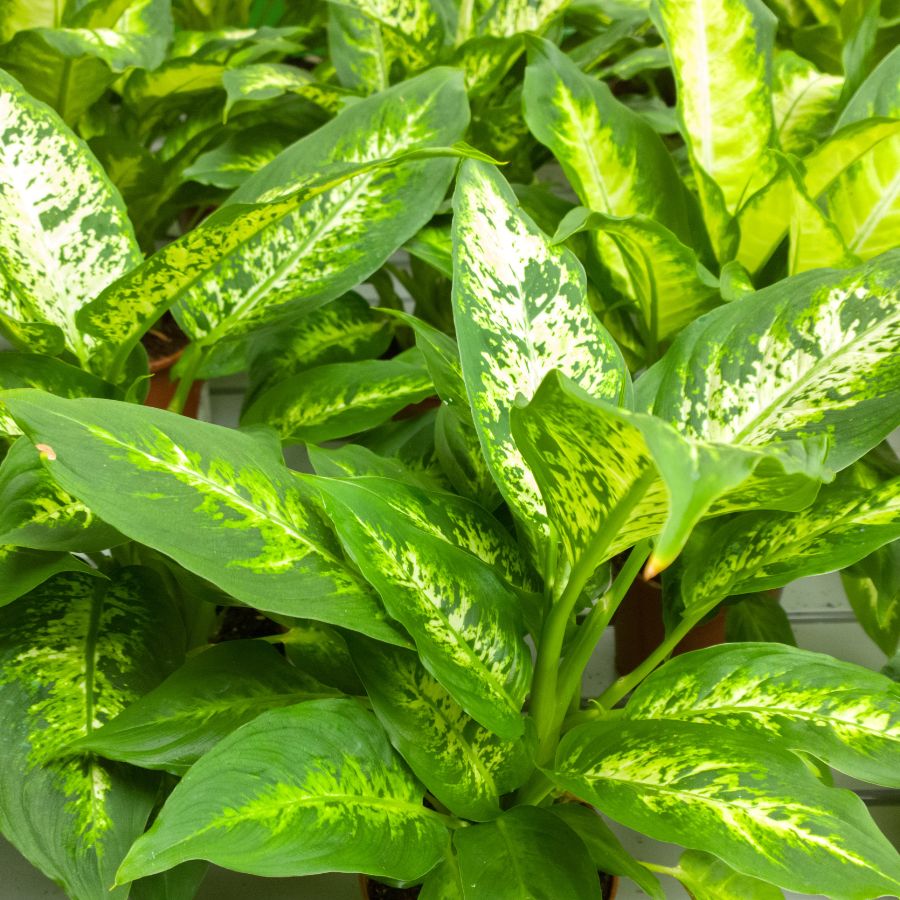Dieffenbachia
Dieffenbachia feature leaves in a variety of combinations of green, cream, and white colors.
Dieffenbachia is a fast-growing plant that can achieve 2 feet in height within a year when grown in the ideal conditions. Typically reach up to 5 feet tall indoors.
Light
Dieffenbachia plants are popular indoor plants largely because they do well in shady conditions, but these plants do appreciate bright light during the winter months. During the growing season, the plant prefers dappled shade or indirect light. The plant will favor the side facing the light, so periodically rotate the plant to keep its growth balanced.
Soil
Use a fast-draining, well-aerated potting mix. Make sure drainage is good to avoid damaging the roots; they should never be left in soggy soil.
Water
During the spring and summer, while actively growing, dieffenbachias like regular moisture and do not want to dry out. However, overwatering can cause root rot. As a guideline – a large dieffenbachia might need to be watered twice a week. In the winter, you can cut back on the water. Make sure the top 2-3 inches of the soil is fully dried out before watering.
Fertilizer
For best results, feed regularly (every four to six weeks) with a balanced, diluted fertilizer, such as a 20-20-20. (For the amount to use, follow product label instructions), and pause fertilizing during the winter.
Types of Dieffenbachia
Of the many species of Dieffenbachia, only a few are commonly sold commercially:
- Camille
- Camouflage
- Seguine
- Tropic Snow
- Carina
- Compacta
- Delilah
- Honeydew
- Mary
- Snow
- Star Bright
- Tropic Marianne
- Panther
- Reflector
Potting and Repotting Dieffenbachia
Dieffenbachias often need annual replanting. Watch for signs that the plant is ready for a larger pot, such as roots poking out from the surface, crowding, or dropped leaves. To repot, simply lift the plant as a whole, knock away any old soil and dead material from the roots, and place it in a larger container with some added fresh soil. After repotting a dieffenbachia, give it some time to adjust to its new setting. (Wear gloves to avoid contact with the sap).
Potential Problems With Dieffenbachia
You will be able to tell a lot about your dieffenbachia by the state of its leaves. Watch for certain colorations on the leaves to let you know what to do to amend conditions.
Leaves Turning Yellow
Overwatering or underwatering your plant can turn the leaves yellow. Often, they will also fall off the plant. Check the soil by sticking a finger 2 inches into the soil. If it’s wet, hold off on watering for a week or so. Cut off the yellow leaves regardless of the reason.
Leaves could also turn yellow because the plant is lacking nutrients, such as nitrogen. Though this can be tough to diagnose, it won’t hurt to use a plant fertilizer to see if will bring your plant back to health.
Drooping Leaves
Dieffenbachia prefers partial shade. If your plant droops, it may mean it’s getting too much sunlight. Move the plant to a spot with indirect sunlight. However, if it’s not getting enough light, the leaves may turn yellow and droop. Move it to an area with a bit more light to alleviate this problem.
The plant may droop because it is cold or near a draft. Keep your plant in a consistently warm area that’s between 65 degrees to 75 degrees.
Toxic Though the name “dumb cane” has fallen out of favor as a derogatory term, it was called that because the plant contains toxins that can inhibit speech. It is highly toxic to humans, dogs, and


